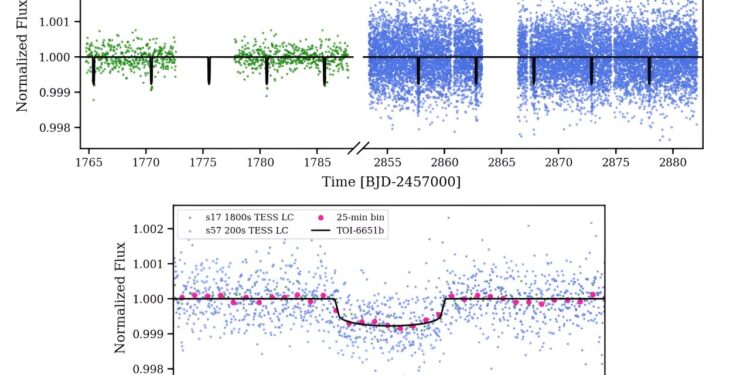Detrended TESS light curve (LC) of TOI-6651 from sectors 17 (1800-second cadence) and 57 (200-second cadence) shown as green and blue dots, respectively. The upper panel shows the full TESS LC plotted as a function of time, while the lower panel shows the phase-folded LC with pink dots representing data points clustered over 25 minutes. The black solid line in both panels represents the best-fit transit model for TOI-6651b from the joint fitting analysis. Credit: Baliwal et al., 2024.
Using the Transiting Exoplanet Survey Satellite (TESS), astronomers at the Physical Research Laboratory (PRL) in Ahmedabad, India, and elsewhere have detected a new sub-Saturnian exoplanet with relatively high density. The discovery was reported in a research paper published September 2 in the Astronomy and astrophysics newspaper.
TESS is surveying about 200,000 of the brightest stars near the Sun to search for transiting exoplanets. So far, it has identified more than 7,200 candidate exoplanets (TESS Objects of Interest, or TOIs), of which 545 have been confirmed to date.
A team of astronomers led by Sanjay Baliwal of PRL has confirmed the existence of another TOI monitored by TESS. They found a transit signal in the light curve of TOI-6651, a G-type subgiant star located about 690 light-years away and estimated to be 3.7 billion years old. The planetary nature of this signal was verified by follow-up observations using ground-based facilities.
“We present the discovery and characterization of a dense sub-Saturn exoplanet, TOI-6651 b, transiting a metal-rich G-type subgiant star,” the researchers wrote in the paper.
According to the study, TOI-6651 has a radius of about 5.09 Earth radii, while its mass is 61 times that of our planet. This gives an apparent density of 2.52 g/cm3making it the densest sub-Saturn detected so far with TESS.
TOI-6651 b orbits its host every 5.05 days in an orbit with an eccentricity of 0.09, at a distance of about 0.06 AU from it. The planet’s equilibrium temperature is estimated to be 1,493 K.
The authors of the study estimate that the mass of TOI-6651 b’s core is about 53 Earth masses. They assume that the planet is composed mainly of dense materials such as rock and iron, which make up about 87% of its total mass. The remaining mass fraction is most likely a low-density hydrogen/helium envelope.
As for the parent star, TOI-6651, it has a radius of about 1.32 solar radii, while its mass is 1.72 solar masses. The star has an effective temperature of 5,940 K and its metallicity has been measured at 0.225 dex.
Summarizing the results, the researchers emphasized that the unusual properties of TOI-6651 b pose a challenge to known theories of planet formation.
“The existence of TOI-6651b challenges conventional theories of planet formation and could be the result of merger events or significant atmospheric mass loss due to tidal heating, highlighting the complex interplay of dynamical processes and atmospheric evolution in the formation of massive and dense sub-Saturns,” the scientists conclude.
More information:
Sanjay Baliwal et al., Discovery and characterization of a dense sub-Saturnian TOI-6651 b, Astronomy and Astrophysics (A&A) (2024). DOI: 10.1051/0004-6361/202450934.
© 2024 Science X Network
Quote:Discovery of a new dense sub-Saturnian exoplanet (September 10, 2024) retrieved September 10, 2024 from
This document is subject to copyright. Apart from any fair dealing for the purpose of private study or research, no part may be reproduced without written permission. The content is provided for informational purposes only.



